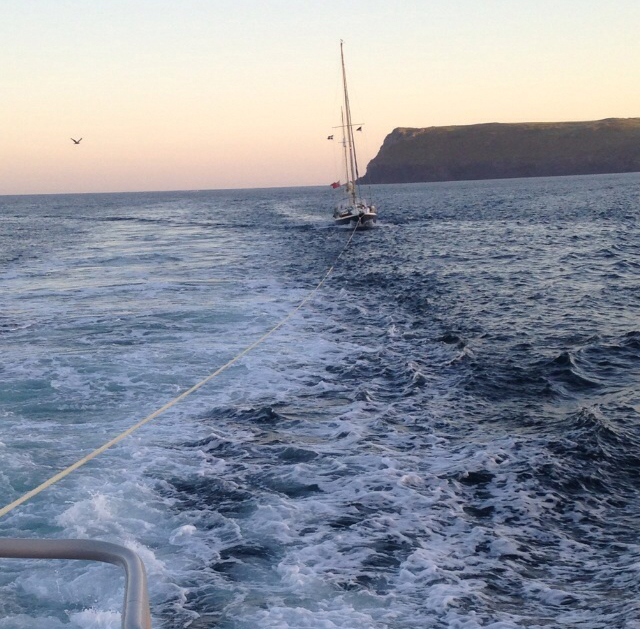The Marine Accident Investigation Branch (MAIB) has now released its report into the fire and sinking of the prawn trawler, Karinya.
14 April
The MAIB’s investigation into the fire and sinking of the trawler, Karinya in the Moray Firth, Scotland has concluded that the cause of the fire can’t be determined. However, it states that the “probable” ignition source was a “poorly discarded cigarette end that was not fully extinguished”
It also stresses the need for all fishing crews to carry out regular emergency drills, as well as the importance of fire prevention, detection and emergency procedures.
The report states that the fire broke out on the Karinya at around 1pm on 4 October, 2015. The skipper, who was aft of the wheelhouse at the winch controls, smelt burning and assumed it was coming from the engine room.
He entered the wheelhouse, heard the fire alarm sounding, and decided to proceed to the engine room to investigate. As he began descending the internal stairway, he saw thick smoke coming out of the open doorway at the top of the stairwell leading down to the cabin.
He could not get close enough to the door to close it, and shouted to the four crew, who were on the aft deck, to collect their lifejackets and to close the doors.
The crew were unable to collect their ship lifejackets as they were stowed in the burning cabin. Instead, they put on inflatable lifejackets that were stored in a locker on the aft deck.
All five crew members then deployed a life raft and abandoned the trawler. They were rescued by a nearby fishing vessel.
The MAIB report highlights a number of safety lessons. It states that although the Karinya was fitted with an automatic fire detection and alarm system, it could not be heard from the winch control position aft of the wheelhouse.
It stresses the importance of “good housekeeping” on a boat, and points out that the Karinya’s cabin contained a lot of combustible material to fuel the fire. This included spare
bedding and crew’s personal effects.
As a result of the trawler not operating a closed-door policy or having a remote closing cabin door, the smoke spread quickly. The MAIB says this could have been prevented if these measures were in place.
The vessel’s lifejackets were stored in the cabin and therefore were inaccessible
due to the volume of smoke from the fire. The MAIB stresses that lifejackets and all other emergency equipment should be “stowed in positions from which they can be readily accessed in an emergency”.
The investigation has concluded that the “rapid and controlled abandonment of Karinya” showed the benefit of all crew members carrying out regular emergency drills. It also demonstrated the benefit of ensuring safety equipment is properly maintained.
5 October
The alarm was raised at about 13:00 on Sunday (04 October) after the Karinya got into difficultly 20 miles from Fraserburgh. A rescue helicopter and the Fraserburgh lifeboat were both sent to the scene and no-one was injured in the fire or rescue.
The Karinya’s emergency broadcast had been picked up by the coastguard and the fishing vessel Pleiades BF155. The crew had abandoned the boat and were rescued from a life raft. They were then airlifted ashore by the coastguard rescue helicopter.
Steve Smith, maritime operations specialist at Aberdeen Coastguard, said: “From the outset it was quite obvious it was a serious fire and the crew subsequently abandoned into their life raft.”
“They did the right thing – the priority is always safety of life. The medic on board the rescue helicopter went down and assessed the crew, who are all safe and well.”
The coastguard later confirmed that the boat sank following the fire but no significant pollution was found in the area.
Fisheries secretary Richard Lochhead said: “The crews of the Pleiades, the Fraserburgh RNLI lifeboat and the rescue helicopter deserve our admiration, our thanks and our praise for responding so quickly and ensuring that the five trawlermen on the Karinya got home safely.
“I am delighted that no-one was injured and this serves as a reminder of what our fishing crews go through to put food on our tables and the emergency services that are there to assist them when they need it.”
Related articles:
Two men rescued from boat in County Antrim
RNLI training exercise turns into real-life rescue
Baby rescued from sinking speedboat in Cornwall
A baby and five adults were rescued from a speedboat that had run into rocks in Plaidy, East Looe on…
RNLI rescues yacht pinned against Poole bridge
The incident took pace during Poole's RNLI recruitment day.
RNLI rescue yacht tangled in crab pot rope in Cornwall
Padstow RNLI lifeboat crew launched to rescue a yacht with propeller damage at 6:55am on Sunday 27 September.
Napoli football club president rescued from burning yacht
Aurelio De Laurentiis was airlifted from the boat in the Gulf of Naples on Sunday ahead of his club's Serie…







